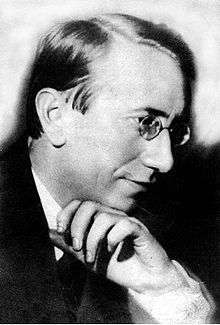Sigizmund Krzhizhanovsky

Sigizmund Dominikovich Krzhizhanovsky (Russian: Сигизму́нд Домини́кович Кржижано́вский; IPA: [sʲɪɡʲɪzˈmunt dəmʲɪˈnʲikəvʲɪtɕ krʐɨʐɨˈnofskʲɪj], Polish: Zygmunt Krzyżanowski; 11 February [O.S. 30 January] 1887 – 28 December 1950) was a Russian and Soviet short-story writer who described himself as being "known for being unknown"; the bulk of his writings were published posthumously.
Life
Krzhizhanovsky was born in Kiev to a Polish family on 11 February 1887.[1]
Judging from his works, major influences on his style were Robert Louis Stevenson, G. K. Chesterton, Edgar Allan Poe, Nikolai Gogol, E. T. A. Hoffmann, and H. G. Wells. Krzhizhanovsky was active among Moscow's literati in the 1920s, while working for Alexander Tairov's Chamber Theater. Several of Krzhizhanovsky's stories became known through private readings, and a couple of them even found their way to print. In 1929 he penned a screenplay for Yakov Protazanov's acclaimed film The Feast of St Jorgen, yet his name did not appear in the credits. He also wrote the screenplay for the 1935 stop-motion animated feature film The New Gulliver, but, again, was left uncredited.[2] One of his last novellas, "Dymchaty bokal" (The smoky beaker, 1939), tells the story of a goblet miraculously never running out of wine, sometimes interpreted as a wry allusion to the author's fondness for alcohol. He died in Moscow, but his burial place is not known.
In 1976, scholar Vadim Perelmuter discovered Krzhizhanovsky's archive and in 1989 published one of his short stories. As the five volumes of his collected works followed, Krzhizhanovsky emerged from obscurity as a remarkable Soviet writer, who polished his prose to the verge of poetry. His short parables, written with an abundance of poetic detail and wonderful fertility of invention – though occasionally bordering on the whimsical – are sometimes compared to the ficciones of Jorge Luis Borges. Quadraturin (1926), the best known of such phantasmagoric stories, is a Kafkaesque novella in which allegory meets existentialism.
Bibliography in English
- "Quadraturin", in Russian Short Stories from Pushkin to Buida. Penguin, 2005. (ISBN 978-0-140-44846-7)
- 7 Stories. GLAS New Russian Writing, 2006. (ISBN 5-7172-0073-0)
- Memories of the Future. New York Review of Books, 2009. (ISBN 978-1-59017-319-0)
- The Letter Killers Club. New York Review of Books, 2011. (ISBN 978-1-59017-450-0)
- Autobiography of a Corpse. New York Review of Books, 2013. (ISBN 978-1-59017-670-2)
References
- ↑ Adam Thirlwell, "Master of the Crossed Out," The New York Review of Books, vol. LVIII, no. 11 (June 23, 2011), p. 57.
- ↑ Sigizmund Krzhizhanovsky. The Complete Works in 5 Volumes. Volume 1. ed. by Vadim Perelmuter. Saint Petersburg: Symposium, 2001, 688 pages. ISBN 5-89091-132-5
External links
- Review of Autobiography of a Corpse
- 'Yellow Coal', a short story by Krzhizhanovsky
- Review of recent Krzhizhanovsky translations from The Financial Times
- Review of Seven Stories
- Brief biography
- Original texts of Krzhizhanovsky's stories (Russian)
- A Man Who Was Gulliver: review of Krzhizhanovsky's complete works (Russian)
|